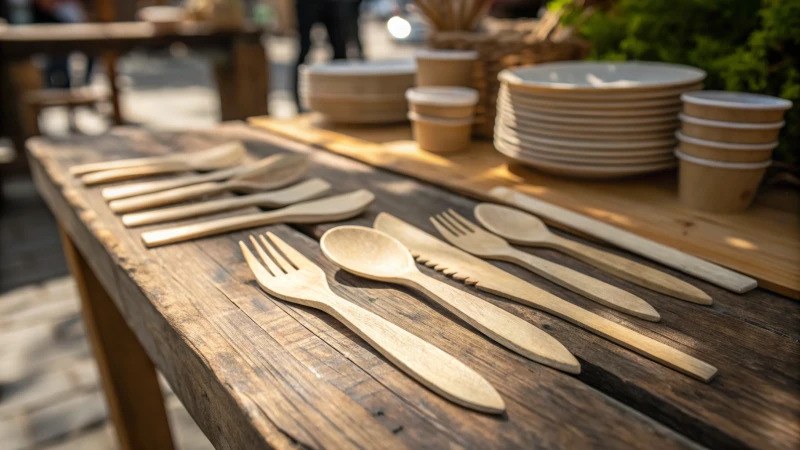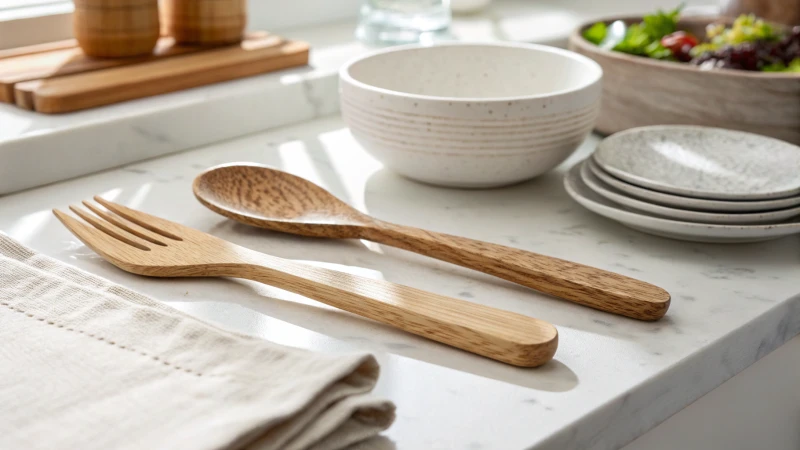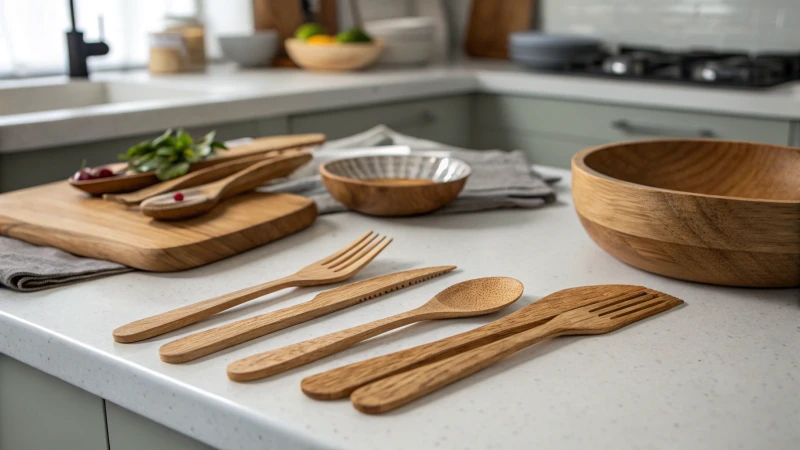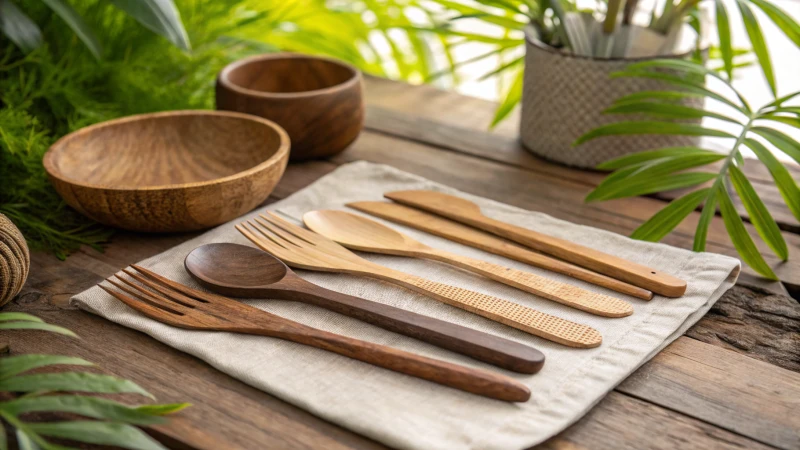
I remember the first time I reached for wooden cutlery, excited about ditching plastic. But then I wondered, is it safe to reuse these pretty little forks and spoons?
Reusing or improperly storing disposable wooden cutlery can lead to bacterial growth and contamination, posing serious health risks. Because wooden utensils are porous, they tend to absorb moisture and can harbor bacteria if not stored properly.
Reflecting on my journey towards sustainable living, I've realized how essential it is to consider health alongside eco-friendliness. Wooden cutlery seems like the perfect solution at first glance—charming, rustic, and biodegradable. But there's more to the story. In this deep dive, let's explore why our eco-friendly choices need a bit of extra care, and discover how you can keep your kitchen both green and clean without compromising safety. From proper storage tips to knowing when it's time to toss those utensils, I've gathered some practical insights that have helped me along the way.
Reusing wooden cutlery increases bacterial contamination risk.True
Wooden cutlery is porous, absorbing moisture and harboring bacteria.
Improper storage of wooden utensils poses no health risks.False
Incorrect storage can lead to bacterial growth, posing health risks.
How does wooden cutlery compare to plastic in terms of hygiene?
Ever found yourself staring at a dinner table, torn between wooden and plastic cutlery? Hygiene plays a big part in this decision, impacting not just personal health but also the planet. Let's dig into how these two materials measure up.
Wooden cutlery, while eco-friendly, can trap bacteria if not stored properly. Plastic is non-porous and easier to clean but less sustainable. Proper cleaning and storage practices can help manage hygiene risks for both.

Material Properties and Their Impact on Hygiene
Wooden Cutlery: I remember hosting a backyard BBQ last summer, where I opted for wooden cutlery because it seemed more environmentally friendly. But I soon realized that wood’s porous nature means it can soak up moisture like a sponge, potentially inviting bacteria if not handled right. Some types of wood have natural antibacterial properties1 that might help, but it's not a foolproof solution.
Plastic Cutlery: On the flip side, plastic cutlery is non-porous, so it doesn’t absorb moisture—making it less of a germ magnet initially. However, after a few too many vigorous cuts into steak, those tiny scratches can become little hideouts for bacteria over time.
Cleaning Practices
| Type | Recommended Cleaning Method | Special Considerations |
|---|---|---|
| Wooden | Rinse with hot water, air dry completely | Avoid soaking to prevent warping |
| Plastic | Dishwasher safe or hand wash | Check for deep scratches |
From my experience, maintaining hygiene with wooden cutlery means being vigilant about drying them thoroughly to avoid any dampness that could lead to mold. Meanwhile, I’ve found plastic cutlery simpler to toss in the dishwasher without much thought—though I make sure to inspect them for scratches occasionally.
Storage Considerations
When I store my wooden utensils, I make sure they’re completely dry and in a well-ventilated area. It's like putting them to bed in a comfy spot where they won't catch a cold! Plastic cutlery doesn’t need this level of pampering but should still be checked for damage that could harbor germs.
Potential Health Risks
I've had moments when improperly stored wooden cutlery showed signs of mold—a stark reminder to be careful. And although plastic seems safer on the hygiene front, it might release microplastics if exposed to high temperatures or as it breaks down over time.
Ultimately, whether you’re leaning towards wooden or plastic, the key is following best practices2 for cleaning and storage. It’s all about finding what fits your lifestyle and environmental values while keeping those germs at bay.
Wooden cutlery is more eco-friendly than plastic.True
Wood is biodegradable and sourced from renewable resources, unlike plastic.
Plastic cutlery harbors less bacteria than wooden cutlery.False
Plastic is non-porous, but scratches can harbor bacteria over time.
How Can You Store Wooden Cutlery Safely?
I remember the first time I held a beautifully crafted wooden spoon and thought, "I want this to last forever." Here's how I make sure my wooden utensils stay in tip-top shape.
To store wooden cutlery safely, keep it in a dry, well-ventilated area, away from sunlight and moisture. Use a holder with drainage to prevent mold, and apply food-grade mineral oil occasionally to maintain quality.

The Importance of Proper Storage
You know, I've learned that storing my wooden cutlery properly is like giving them a little spa day every time I put them away. It prolongs their lifespan and keeps them hygienic. Unlike their metal or plastic counterparts, wood is porous. This means it can soak up moisture like a sponge, and that’s where trouble begins—think bacteria and mold.
Ideal Storage Conditions
- Ventilation: I use a utensil holder that lets air flow freely. It’s like giving my cutlery a breath of fresh air, preventing any sneaky moisture from settling in.
- Temperature: Keeping them away from direct heat is crucial. I learned this the hard way when I left a spoon too close to the stove—warp city!
- Humidity: A dry area is best because, as I’ve noticed, moisture is the enemy when it comes to mold and bacterial growth.
| Storage Feature | Benefit |
|---|---|
| Ventilated Holder | Reduces moisture |
| Cool Environment | Prevents warping |
| Dry Area | Inhibits mold growth |
Maintenance Tips
Even with careful storage, I’ve found that regular maintenance is key. Every few months, I treat my wooden cutlery to a coat of food-grade mineral oil3. This isn’t just about preserving the wood; it’s like giving them a shield against water absorption.
Avoiding Common Mistakes
I used to store my cutlery in airtight containers thinking it would keep them safe—big mistake! It trapped moisture. Also, stacking them in damp drawers is a no-go; it can lead to warping and mold.
If you’re curious about more ways to keep your kitchen eco-friendly, explore sustainable options4 that fit your lifestyle. Trust me, ensuring your wooden cutlery is stored properly not only keeps them looking good but also guarantees they’re safe to use for years to come.
Wooden cutlery should be stored in airtight containers.False
Airtight containers trap moisture, promoting mold and bacteria.
Applying mineral oil preserves wooden cutlery.True
Mineral oil protects wood from water absorption, extending its life.
Can Wooden Cutlery Be Safely Reused After Sanitizing?
Have you ever found yourself pondering whether your trusty wooden cutlery can be safely reused?
Wooden cutlery can indeed be sanitized for safe reuse by employing methods like immersing in boiling water, using natural antibacterial solutions, and ensuring thorough drying. Yet, it's vital to inspect each piece for damage before reuse to guarantee safety.

I remember when I first switched to wooden cutlery; it felt like a small but significant step towards living sustainably. However, I couldn't help but worry about hygiene each time I considered reusing them. I mean, the idea of bacteria lurking in those little wooden fibers made me uneasy.
Understanding Wooden Cutlery Material
Using wooden cutlery has always appealed to me not just for its earthy aesthetic but also its eco-friendliness. But, let's face it—wood's porous nature is a double-edged sword. It can soak up all sorts of things, including moisture and bacteria, which means we need to be extra careful about how we clean and reuse them.
Pros and Cons of Wooden Utensils
| Pros | Cons |
|---|---|
| Biodegradable | Absorbs moisture |
| Aesthetic appeal | Prone to bacterial growth |
| Eco-friendly alternative | May warp or crack with prolonged use |
Effective Sanitization Methods
Over time, I've tried various methods to keep my wooden utensils safe for reuse. Here are the ones that have worked best for me:
- Boiling Water: I submerge the cutlery in boiling water for a few minutes. It's simple and effective, but I make sure they're completely dry afterward.
- Vinegar Solution: Mixing equal parts of water and white vinegar creates a great natural disinfectant. I soak the utensils for a few minutes, rinse, and dry them thoroughly.
- Hydrogen Peroxide: Occasionally, I use a hydrogen peroxide solution. It’s crucial to rinse well afterward, but it leaves no harmful residues.
Proper Drying Techniques
After cleaning, drying is non-negotiable. I lay them out on a rack in a breezy area or let them bask in some direct sunlight—it’s surprising how effective that can be at zapping away any lingering germs.
Assessing Condition Before Reuse
Before considering reuse, I always inspect each piece for cracks or warps. Any damaged ones get tossed to avoid any health risks. Inspecting utensils5 is an essential part of this ritual.
When to Replace Wooden Cutlery
Even with the best care, wooden cutlery has its limits. Frequent use can wear them down over time. I usually check for signs of wear after several uses and replace them if needed. Understanding why replace often6 helps me stay on top of potential bacterial threats and maintain my health standards.
Wooden cutlery can harbor bacteria due to its porous nature.True
Wood's porous nature allows moisture and bacteria absorption, requiring careful sanitization.
Boiling water is ineffective for sanitizing wooden cutlery.False
Boiling water effectively kills most germs on wooden cutlery when used properly.
What Are the Environmental Benefits of Using Wooden Cutlery?
Ever thought about how your choice of cutlery could help the planet?
Wooden cutlery offers a sustainable alternative to plastic by being biodegradable and compostable. It's often made from renewable resources, helping to reduce waste and carbon emissions while promoting eco-friendly practices.

Reducing Plastic Waste
I remember the first time I realized how much plastic cutlery was piling up in landfills and oceans. It was a documentary that opened my eyes to the mountains of waste we create. It made me think about the alternatives, like wooden cutlery, which naturally breaks down in just a few months. By choosing wooden options, not only are we helping to combat this overwhelming issue of plastic pollution7, but we're also playing a part in conservation efforts.
Biodegradability and Composting
The beauty of wooden cutlery lies in its simplicity. Made from natural materials, it decomposes with ease. I’ve started composting at home, and tossing wooden utensils into the bin feels like a small yet significant step towards enriching the soil. Unlike plastic, which can linger for centuries, wooden utensils transform into organic matter without leaving harmful residues. Curious about how composting can benefit your garden? Check out composting benefits8.
Sustainable Sourcing Practices
One thing I’m really passionate about is ensuring that the products I use come from sustainable sources. Many wooden cutlery items are produced from sustainably managed forests, ensuring trees are replenished and ecological balance is maintained. Companies often hold certifications like the Forest Stewardship Council (FSC), which I always look for when buying. Want to know more about sustainable forestry9 efforts? It's worth the read.
Carbon Footprint Reduction
Producing wooden cutlery usually requires less energy than making plastic utensils, which means fewer carbon emissions. I’ve learned that these processes often use renewable energy sources, boosting their environmental friendliness. Interested in how energy-efficient manufacturing10 contributes to carbon reduction? It's fascinating how small changes can make a big impact.
Supporting Circular Economy
Switching to wooden cutlery fits right into the circular economy by pushing for resource efficiency and less waste. In this model, materials are reused or recycled, cutting down on new raw materials and landfill contributions. Dive into how circular economies11 are driving sustainability through innovation.
| Environmental Benefit | Wooden Cutlery | Plastic Cutlery |
|---|---|---|
| Biodegradability | Yes | No |
| Compostable | Yes | No |
| Renewable Resources Sourcing | Often | Rarely |
| Carbon Emission Reduction | Lower | Higher |
Incorporating wooden cutlery into our daily lives isn't just about convenience—it's about making a conscious choice to support a sustainable environment. Understanding these benefits helps us all make decisions that reflect our eco-friendly values. So next time you grab a fork or spoon, think about the impact you're making.
Wooden cutlery reduces landfill waste.True
Wooden cutlery decomposes naturally, unlike plastic, reducing landfill waste.
Plastic cutlery is compostable.False
Plastic does not decompose easily and isn't suitable for composting.
Conclusion
Improper reuse or storage of wooden cutlery can lead to bacterial growth, posing health risks. Proper cleaning and storage are essential for maintaining hygiene while enjoying eco-friendly benefits.
-
Discover how certain woods naturally inhibit bacterial growth, enhancing hygiene in cutlery. ↩
-
Explore guidelines to ensure hygienic use of both wooden and plastic cutlery. ↩
-
Discover why food-grade mineral oil is recommended for preserving and protecting wooden utensils. ↩
-
Explore additional eco-friendly practices to enhance your kitchen's sustainability. ↩
-
Provides guidelines on inspecting utensils for cracks or damage that might harbor bacteria. ↩
-
Explains why frequent replacement of wooden cutlery is necessary due to wear and potential bacterial risks. ↩
-
Understand the impacts of plastic waste on ecosystems and global pollution issues. ↩
-
Learn how composting improves soil quality and supports eco-friendly waste management. ↩
-
Explore forestry techniques that promote ecological balance and resource sustainability. ↩
-
Discover how reduced energy consumption in production benefits the environment. ↩
-
Find out how circular economies enhance sustainability by reducing waste. ↩

